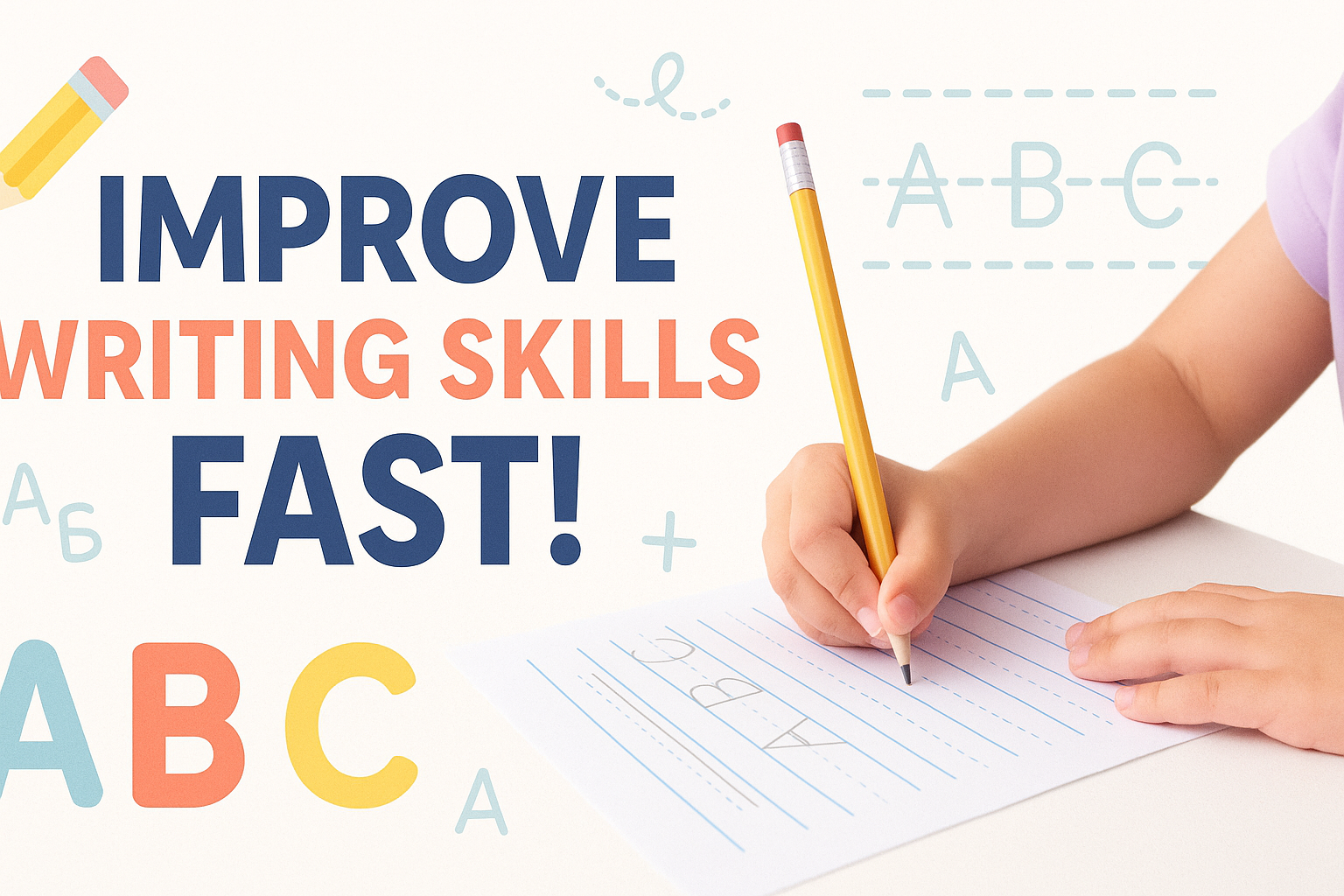How to Improve Kids’ Writing Skills (30-Day Plan + Proven Activities)

Improve your child’s handwriting with this proven, research-backed 30-day writing skills plan. Includes pencil grip tips, pre-writing activities, fine motor games
How to Improve Kids’ Writing Skills: Step-by-Step Plan (Ages 3–8)
A practical, research-backed guide to improve handwriting and writing readiness at home or in class. This article includes daily routines, games that build pencil grip & fluency, lesson progressions, printable ideas and a 30-day practice plan so your child shows visible improvement in weeks.
Why handwriting and writing readiness matter
Handwriting is not just neat letters — it supports reading, working memory and composition skills. Research shows that fine motor control and early handwriting practice improve legibility and fluency, which in turn helps children write more and learn faster. For practical classroom frameworks and national guidance on explicit handwriting instruction, see the UK Writing Framework and evidence reviews. :contentReference[oaicite:1]{index=1}
Writing readiness: what to check before formal writing
- Pencil grip & hand strength: ability to hold a pencil (tripod or adaptive), press with control.
- Fine motor precision: buttoning, bead-stringing, cutting along a line.
- Visual-motor integration: copying shapes, tracing lines left→right.
- Posture & core strength: sitting upright with feet supported.
- Directionality & pre-writing patterns: top→bottom, left→right movement practice.
These predictors are commonly referenced in handwriting research and educational guidance. :contentReference[oaicite:3]{index=3}
40+ Activities & Exercises to Improve Writing (sorted by level)
Beginner (ages 3–4): play-based foundations
Focus: hand strength, bilateral coordination, finger isolation.
- Playdough pinching & rolling: pinch tiny balls, roll snakes — 5 mins.
- Sticker peeling: peel & stick to make patterns — excellent pincer control.
- Pom-pom tweezers: pick and transfer pom-poms into cups using tweezers.
- Clothespin clips: clip clothespins along cardboard edges.
- Rice bin scooping: scoop & pour using spoons and small containers.
These activities match the fine-motor foundations recommended in occupational-therapy literature. :contentReference[oaicite:4]{index=4}
Intermediate (ages 4–6): pre-writing shapes → letter formation
- Tracing on slanted board: use a slant board or clipboard — promotes wrist extension.
- Dot-to-dot & maze tracing: left→right trails, increasing complexity. (5–10 minutes)
- Chalkboard big-arm tracing: use large chalk for whole-arm movement then shrink to pencil size.
- Broken-line letter tracing: trace dotted letters; then copy freehand.
- Pencil control games: draw through a narrow path while staying inside the lines.
Tracing/structured practice is proven useful to build motor memory before freehand writing. :contentReference[oaicite:5]{index=5}
Advanced (ages 6–8): fluency, speed & composition
- Timed handwriting sprints: short 1–2 minute writes to build automaticity.
- Copy passages: copy 2–3 lines focusing on spacing and letter size.
- Dictation + rewrite: dictate 1–2 sentences, child writes then rewrites improving legibility.
- Handwriting into composition: mini journal entries (3–4 sentences) to combine content + handwriting.
- Keyboard vs pen practice: continue handwriting practice even if typing is taught — handwriting supports reading & memory. :contentReference[oaicite:6]{index=6}
Recommended tools & how to use them
| Tool | Why | How to use |
|---|---|---|
| Thick triangular pencils | easier to grip | Begin with thick pencils then move to standard hex pencil |
| Slant board / clipboard | improves wrist posture | Use for tracing & copying tasks |
| Dot marker sheets | encourages controlled dot placement | Use for letter-start practice |
| Playdough | builds hand strength | pinching, rolling, buttoning games |
30-Day Practice Plan (15–20 minutes each day)
Goal: build grip → controlled letter formation → fluency. This plan blends play, tracing and short writing tasks.
Weekly pattern
- Mon–Wed: Fine motor + tracing (10–15 mins)
- Thu: Pencil control game + copying (15 mins)
- Fri: Fun composition (dictation + drawing) (15–20 mins)
- Sat: Mixed play (playdough + tweezers) + optional printable
- Sun: Free play / review (observe improvements)
Sample days (first week)
- Day 1: 5 min playdough pinch, 5 min tracing big shapes, 5 min dot-to-dot.
- Day 3: Tweezers transfer 5 min, tracing letters with broken lines 10 min.
- Day 6: Slant-board big-arm tracing 5 min, copying 2 short words 10 min.
Repeat with gradual increase in difficulty. Track with a simple sticker chart to keep motivation high.
How to teach letter formation, spacing & fluency (step-by-step)
- Model first: show how to form letters slowly — narrate movements (“start at top, go round”).
- Trace: tracing builds motor memory — start dotted lines then remove supports.
- Copy: copy 1–2 letters, then 1 word, then short phrase.
- Spacing practice: use finger-space method (use a small stick or finger between words).
- Speed last: ensure legibility before increasing speed; use short timed tasks for fluency training.
National teaching guidance recommends explicit, sequenced handwriting lessons starting at reception/early years (structured, cumulative teaching). :contentReference[oaicite:7]{index=7}
Sample mini-lesson (7 minutes)
- 30s: warm-up finger exercises (pinch, tap)
- 2 min: model new letter + say stroke directions
- 2 min: child traces dotted letter
- 2 min: child copies letter in own space
Related Kideos Station posts (internal links)
Verified resources & further reading (research-backed)
- Fine motor skills and handwriting legibility study (PMC). Evidence on fine motor → handwriting. :contentReference[oaicite:8]{index=8}
- UK Writing Framework — sequenced handwriting instruction (gov.uk). Practical curriculum guidance. :contentReference[oaicite:9]{index=9}
- Reading Rockets — 12 best practices for writing in early childhood. Great classroom strategies. :contentReference[oaicite:10]{index=10}
- National Handwriting Association — practical phonics + handwriting advice. Useful multisensory techniques. :contentReference[oaicite:11]{index=11}
- Education Endowment Foundation — Helping Handwriting Shine (intervention trial). Classroom-tested program. :contentReference[oaicite:12]{index=12}
Frequently Asked Questions
Q: When should I worry about my child’s handwriting?
If by age 6–7 your child struggles with basic letter formation, spacing, or is extremely slow and frustrated, consult the teacher and consider occupational-therapy screening. Early intervention helps. :contentReference[oaicite:13]{index=13}
Q: How long before I see improvement?
With daily 15–20 minute targeted practice, noticeable improvements in control & legibility often appear within 3–6 weeks. Keep progress charts to motivate kids.
Q: Should I prioritize typing or handwriting?
Both matter — handwriting supports reading and memory. Even when teaching typing, keep short handwriting practice sessions for fluency. :contentReference[oaicite:14]{index=14}
how to improve kids writing skills at home
handwriting practice for 4 year olds
writing readiness activities for preschoolers
pencil grip activities for toddlers
how to teach letter formation step by step
pre writing activities for nursery kids
best writing activities for 3 to 6 year olds
kids handwriting improvement tips
how to improve handwriting for child at home
writing skills development for early learners

